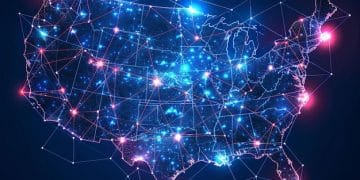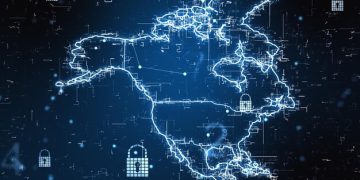US Tech: AI Ethics Guidelines 2025 Impact Explored

The updated AI ethics guidelines in 2025 are poised to significantly reshape how US tech companies develop and deploy AI, demanding a proactive shift towards responsible innovation, enhanced transparency, and robust accountability frameworks to navigate evolving regulatory landscapes and maintain public trust.
As artificial intelligence continues its rapid integration into our daily lives, the question of responsible development becomes paramount. In 2025, how will the updated AI ethics guidelines impact US tech companies? This evolving regulatory landscape promises to be a critical turning point for innovation, demanding a fresh look at current practices and future strategies.
Understanding the Landscape of AI Ethics Regulation
The regulatory environment surrounding artificial intelligence is in a constant state of flux. Historically, the rapid pace of technological innovation has often outstripped legislative efforts, creating a vacuum where ethical considerations are largely self-governed by tech companies. However, this dynamic is quickly changing as policymakers worldwide recognize the profound societal implications of AI.
In the United States, 2025 is shaping up to be a pivotal year for AI ethics. Expect to see a more defined framework emerging, moving beyond abstract principles to concrete requirements. This shift is driven by a confluence of factors, including growing public concern over issues like bias, privacy, and accountability, as well as an increasing global push for standardized AI governance.
Key Drivers of Regulatory Change
Several forces are compelling the US government to formalize AI ethics guidelines. Advocacy groups are tirelessly campaigning for stronger protections, citing instances where AI has perpetuated discrimination or undermined democratic processes. Simultaneously, a greater understanding of AI’s capabilities and limitations by lawmakers is fostering a more informed approach to regulation.
- Public Scrutiny: Heightened awareness of AI’s potential harms by the general public.
- International Pressure: Global efforts, like the EU’s AI Act, influencing US policy direction.
- Technological Maturity: AI systems becoming powerful enough to warrant formal oversight.
- Corporate Responsibility Calls: Demands for tech companies to shoulder more ethical weight.
These drivers together create an imperative for US tech companies to anticipate and adapt to stricter guidelines. Ignoring these trends could result in significant reputational damage, legal penalties, and a loss of market share to more ethically compliant competitors.
The evolving regulatory landscape is not merely about compliance; it’s about embedding ethical considerations into the very core of AI development and deployment. This proactive approach will be essential for tech companies aiming to thrive in the regulated future.
Data Governance and Privacy: A Cornerstone of New Guidelines
At the heart of many updated AI ethics guidelines lies the critical issue of data governance and privacy. AI systems are inherently data-hungry, and the quality, source, and handling of this data directly impact ethical outcomes. In 2025, US tech companies will face increased scrutiny over how they collect, store, process, and utilize personal and sensitive information.
The new guidelines are expected to go beyond existing privacy laws, such as the California Consumer Privacy Act (CCPA), by specifically addressing AI’s unique challenges. This could mean more rigorous requirements for consent, anonymization techniques, and data lifecycle management tailored to algorithmic operations. The goal is to prevent biases embedded in training data from propagating into AI decisions and to protect individual liberties.
Enhanced Transparency in Data Practices
Transparency will become a non-negotiable aspect of data governance. Companies will likely need to provide clearer explanations to users about what data is being collected, why it’s being collected, and how AI systems use it. This moves beyond boilerplate privacy policies to more accessible, understandable disclosures.
- Clearer Consent: Opt-in mechanisms for data use, especially for sensitive categories.
- Detailed Data Audits: Regular checks to ensure data quality and ethical sourcing.
- Explainable Decisions: Requirements to articulate how data leads to AI outcomes.
- Data Minimization: A focus on collecting only the data essential for a given purpose.

The emphasis on data privacy and governance will require significant investment in infrastructure, talent, and processes. Companies that already prioritize privacy-by-design principles will have a head start, while those lagging behind may face significant hurdles in adapting their data practices to the new ethical standards.
Ultimately, these guidelines aim to build trust. When users feel confident that their data is handled responsibly, they are more likely to engage with AI-powered services, fostering a healthier digital ecosystem for both consumers and businesses.
Algorithmic Bias and Fairness: Addressing Systemic Inequities
One of the most pressing ethical concerns in AI is algorithmic bias, where systems inadvertently (or sometimes overtly) perpetuate and amplify societal inequalities. In 2025, updated AI ethics guidelines for US tech companies will place a strong emphasis on mitigating these biases and promoting fairness in AI systems.
These guidelines will likely mandate proactive measures to identify and address bias across the entire AI development lifecycle, from data collection and model training to deployment and continuous monitoring. The aim is to ensure that AI systems do not disadvantage particular groups based on race, gender, socio-economic status, or other protected characteristics.
Tools and Techniques for Bias Detection and Mitigation
Tech companies will need to adopt sophisticated tools and methodologies to achieve algorithmic fairness. This includes developing diverse and representative training datasets, implementing fairness metrics to evaluate model performance across different demographic groups, and incorporating bias detection algorithms.
- Representative Datasets: Ensuring training data reflects demographic diversity.
- Fairness Audits: Regular assessment of AI outputs for discriminatory patterns.
- Transparent Algorithms: Designing systems whose decision-making process can be understood.
- Human Oversight: Integrating human review into critical AI decision pathways.
Moving forward, the emphasis will not just be on identifying bias, but on actively working towards ‘fair by design’ AI. This involves a cultural shift within tech companies, promoting diversity in development teams and integrating ethical considerations from the initial conceptualization of an AI product.
Companies that demonstrate a genuine commitment to fairness, not just compliance, will likely gain a competitive advantage and earn greater public trust. This proactive approach to algorithmic bias transforms a regulatory challenge into an opportunity for true innovation in responsible AI.
Accountability and Explainability: Demanding Clarity from AI
As AI systems become more complex and autonomous, the questions of who is accountable when things go wrong and how their decisions are made take center stage. In 2025, US tech companies will face updated AI ethics guidelines that significantly tighten requirements for accountability and explainability.
Explainable AI (XAI) is not merely a technical concept; it’s an ethical imperative. Users, regulators, and affected individuals need to understand why an AI system made a particular decision. The “black box” approach, where algorithms operate without clear internal logic, will become increasingly untenable under the new regulations.
Establishing Clear Accountability Frameworks
The guidelines are expected to define clearer lines of responsibility within tech companies for the ethical performance of their AI products. This could involve assigning specific roles, establishing internal review boards, and implementing robust logging and auditing mechanisms for AI decisions.
- Designated AI Ethics Officers: Individuals responsible for overseeing ethical compliance.
- Impact Assessments: Mandatory evaluations of potential ethical risks before deployment.
- Audit Trails: Comprehensive records of AI decisions and the data inputs used.
- Remediation Processes: Clear pathways for users to challenge or seek recourse for AI errors.
The push for explainability means a shift in AI development methodologies. Developers will need to move beyond optimizing solely for performance and also consider interpretability. This might involve favoring simpler, more transparent models where appropriate, or developing sophisticated tools to interpret complex neural networks.
Embracing accountability and explainability is a significant undertaking, but it’s crucial for building public confidence in AI. Companies that proactively invest in these areas will not only comply with future regulations but also foster a more trustworthy and responsible AI ecosystem.
Impact on AI Development Lifecycles and Business Operations
The updated AI ethics guidelines in 2025 will not be confined to a single aspect of tech operations; they will permeate the entire AI development lifecycle and profoundly influence business strategies. US tech companies must prepare for a holistic transformation in how they conceive, design, build, test, deploy, and monitor AI systems.
From the initial brainstorming phase to post-deployment maintenance, ethical considerations will become integral at every stage. This means integrating ethics into technical specifications, project management, and even procurement processes for AI components or data. The days of retrofitting ethics onto a finished product will be over.
Redefining ‘Good’ AI Products
The definition of a ‘good’ AI product will expand beyond functionality and efficiency to include ethical robustness. This translates into new metrics for success, where factors like fairness, transparency, and accountability are as important as speed or accuracy. Companies will need to invest in training their entire workforce on these new ethical benchmarks.
- Ethical Design Principles: Integrating ethics from the earliest stages of product conceptualization.
- Cross-functional Ethics Teams: Collaboration between engineers, lawyers, ethicists, and business leaders.
- Long-term Monitoring: Continuous assessment of AI systems for evolving ethical risks.
- Supply Chain Ethics: Ensuring ethical practices extend to third-party data providers and models.

Operationally, compliance might entail significant resource allocation. This includes hiring ethics specialists, retraining existing staff, and overhauling quality assurance protocols to incorporate ethical evaluations. Companies might also need to adapt to slower development cycles, as ethical vetting adds necessary stages to the process.
Ultimately, these changes are an investment in the longevity and public acceptance of AI technology. By embedding ethics into their core operations, US tech companies can build more resilient, trustworthy, and socially responsible AI products that stand the test of time and regulation.
Innovation vs. Regulation: Finding a Balance
A perennial concern whenever new regulations emerge is the potential for stifling innovation. For US tech companies, the updated AI ethics guidelines in 2025 present a delicate balance: how to foster groundbreaking AI advancements while adhering to a stricter ethical framework. The key lies not in viewing regulation as an impediment, but as a framework for responsible innovation.
Instead of slowing down progress, well-crafted ethical guidelines can actually guide innovation towards more socially beneficial and sustainable outcomes. They encourage companies to think creatively about thorny ethical problems, leading to novel solutions that might not have emerged under purely performance-driven development.
Fostering Responsible AI Ecosystems
The new guidelines are likely to encourage the development of a broader ecosystem around responsible AI, including new tools, services, and research dedicated to ethical integration. This could open up new market opportunities for startups specializing in AI ethics consulting, auditing, or specialized software.
- Ethical Tech Startups: Growth of companies focusing on AI fairness and transparency tools.
- Academic-Industry Partnerships: Collaborations to research and implement ethical AI solutions.
- Standardization Bodies: Development of common technical standards for ethical AI performance.
- Talent Development: Increased demand for interdisciplinary professionals skilled in both AI and ethics.
The challenge for tech companies will be to proactively engage with policymakers and ethical experts to shape practical and effective regulations. By contributing their technical expertise, companies can help ensure that guidelines are both robust and flexible enough to accommodate future technological advancements.
Finding this balance means adopting a mindset where ethical considerations are seen as a competitive advantage rather than a burden. Companies that manage to innovate within, and even leverage, the new ethical boundaries will likely be the ones that lead the AI landscape in 2025 and beyond.
Global Impact and Competitive Advantage for US Tech
The updated AI ethics guidelines in the US for 2025 won’t operate in a vacuum; they will have significant global repercussions and could redefine the international competitive landscape for US tech companies. As other nations, particularly the European Union, move forward with their own comprehensive AI regulations, the US approach will influence global standards and market access.
A robust and clear set of ethical guidelines could position US tech companies as leaders in responsible AI development. This could be a distinct competitive advantage, especially in markets where consumers and governments prioritize ethical sourcing and privacy. Companies that proactively adapt will be better prepared to navigate a complex international regulatory environment.
Navigating International Regulations
Compliance with US guidelines may also help streamline adherence to similar, yet distinct, international regulations. Developing a strong internal framework for ethical AI can serve as a foundation for meeting requirements from multiple jurisdictions, reducing compliance costs and increasing market agility.
- Interoperability: Potential for US guidelines to influence international policy convergence.
- Market Access: Ethical compliance becoming a de facto requirement for global trade.
- Reputational Gains: Being seen as a leader in trustworthy AI enhances brand value globally.
- Talent Attraction: Companies committed to ethics may attract top global AI talent.
Conversely, a disjointed or insufficient US regulatory response could leave American tech companies at a disadvantage. Without clear ethical guardrails, they might struggle to gain trust in international markets, face stricter barriers to entry, or even be perceived as less responsible innovators compared to their global counterparts.
Thus, the 2025 AI ethics guidelines are not just about domestic policy; they are a strategic move that could bolster the US’s standing as a global leader in technology. For US tech companies, embracing these updates is crucial for maintaining and expanding their international competitive edge.
| Key Area | Impact on US Tech |
|---|---|
| ⚖️ Regulatory Compliance | Mandates proactive adherence to federal and state ethical standards, shifting from self-governance. |
| 🔒 Data Privacy & Governance | Requires enhanced transparency, consent, and stricter data handling throughout AI lifecycle. |
| 🛡️ Bias Mitigation & Fairness | Demands systematic identification and reduction of algorithmic bias to ensure equitable outcomes. |
| 📈 Operational Shift | Integrates ethical considerations into every stage of AI development, requiring new roles and processes. |
FAQs: Navigating AI Ethics in US Tech
The primary drivers include increased public concern over AI’s impact, international regulatory pressure from initiatives like the EU AI Act, and a growing understanding among policymakers of AI’s societal implications. These factors are compelling a shift from self-governance to more formalized ethical frameworks.
Data privacy practices will see enhanced transparency requirements, stricter consent mechanisms, and more rigorous data governance throughout the entire AI lifecycle. Companies will need to prioritize data minimization and implement advanced anonymization techniques to comply with new standards and prevent bias.
Algorithmic fairness involves proactive measures to identify, assess, and mitigate biases in AI systems. This includes creating diverse training datasets, performing regular fairness audits, and developing intrinsically transparent algorithms to ensure AI does not perpetuate or amplify existing societal inequalities.
While some initially fear regulation may stifle innovation, these guidelines are designed to foster responsible innovation. By providing clear ethical boundaries, they encourage creative solutions to complex problems, potentially opening new market opportunities in ethical AI tools and services. Companies can gain a competitive edge by leading in responsible development.
The US AI ethics guidelines are expected to influence global AI standards. By adopting robust frameworks, US tech companies can become leaders in responsible AI, enhancing their international competitive advantage and market access. Conversely, a weak approach could disadvantage them against ethically compliant global competitors.
Conclusion
The advent of updated AI ethics guidelines in 2025 marks a transformative period for US tech companies. This shift necessitates a profound re-evaluation of how AI is developed, deployed, and governed, moving far beyond mere technical efficiency to embrace core principles of fairness, transparency, and accountability. While the initial adaptation may present challenges, proactive engagement with these guidelines is not just about compliance; it’s an opportunity to rebuild public trust, foster truly responsible innovation, and secure a competitive edge in a rapidly evolving global landscape. Ultimately, the future of AI in the US will be defined by its ethical foundations, ensuring technology serves humanity responsibly.





